No Ban on Anonymous Crypto Wallets in EU, Expert Confirms
March 26, 2024 | by stockcoin.net


Recent discussions surrounding the European Union’s (EU) approach to cryptocurrency anonymity have sparked widespread speculation. Industry expert Patrick Hansen has addressed these claims, providing clarity on the matter. The EU’s Anti Money Laundering Regulation (AMLR) does not specifically target cryptocurrencies but offers a broader framework. It focuses on anti-money laundering and counter-terrorism financing, encompassing a variety of sectors, including crypto-asset service providers (CASPs), and extends to non-financial entities at risk of AML/CFT violations. Contrary to rumors of an outright ban on anonymous crypto wallets and transactions, the AMLR includes provisions for these technologies, emphasizing the EU’s nuanced stance towards digital asset regulation.
EU’s Approach to Cryptocurrency Anonymity
Recent discussions surrounding the European Union’s (EU) approach to cryptocurrency anonymity have sparked widespread speculation. Industry expert Patrick Hansen has addressed these claims, providing clarity on the matter. The EU’s Anti Money Laundering Regulation (AMLR) does not specifically target cryptocurrencies but offers a broader framework. It focuses on anti-money laundering and counter-terrorism financing. This encompasses a variety of sectors, including crypto-asset service providers (CASPs), and extends to non-financial entities at risk of AML/CFT violations.
EU’s Anti Money Laundering Regulation
The EU’s Anti Money Laundering Regulation (AMLR) forms the basis of the EU’s approach to cryptocurrency anonymity. It is designed to combat money laundering and the financing of terrorism, which are global concerns affecting various sectors. The AMLR provides a framework for tackling these issues, and while it does not specifically target cryptocurrencies, it includes provisions that apply to CASPs and non-financial entities.
Focus on Anti-money Laundering and Counter-terrorism Financing
The primary focus of the EU’s approach to cryptocurrency anonymity is to address the risks associated with money laundering and the financing of terrorism. By implementing regulations and measures that target these issues, the EU aims to promote transparency, accountability, and security within the financial system. This approach is in line with international efforts to combat illicit activities and protect the integrity of financial markets.
Applicability to Crypto-asset Service Providers (CASPs) and Non-financial Entities
The EU’s Anti Money Laundering Regulation applies to a wide range of entities, including CASPs and non-financial entities. CASPs, such as exchanges and brokers, are subject to specific requirements under the Markets in Crypto-Assets (MiCA) framework. These requirements include adherence to know-your-customer (KYC) and anti-money laundering (AML) procedures, as well as the prevention of anonymous accounts and services. Non-financial entities that are at risk of money laundering or terrorist financing activities are also covered by the AMLR.
Exemption for Non-Custodial Wallet Providers
Contrary to rumors of an outright ban on anonymous crypto wallets and transactions, the AMLR includes provisions that exempt non-custodial wallet providers from its requirements. Non-custodial wallets are a type of digital wallet that allows users to control their private keys and, consequently, their assets directly. This exemption highlights the EU’s nuanced stance towards digital asset regulation, as it recognizes the importance of user control and privacy while still addressing money laundering and terrorist financing risks.
Definition of Non-Custodial Wallets
Non-custodial wallets are digital wallets that do not involve a third-party custodian holding the user’s private keys or assets. Instead, users have full control over their private keys and are solely responsible for the security and management of their assets. This distinction is crucial in understanding the exemption provided to non-custodial wallet providers under the EU’s Anti Money Laundering Regulation. By exempting these providers, the EU acknowledges the importance of user control and privacy in the context of cryptocurrency transactions.
Users’ Control Over Private Keys and Assets
One of the key advantages of non-custodial wallets is that they give users complete control over their private keys and assets. This means that users are not reliant on a third-party custodian to store or manage their cryptocurrencies. Instead, they have the responsibility and opportunity to safeguard their assets themselves. Non-custodial wallets offer a higher level of security and privacy compared to custodial wallets, as there is no central point of failure or vulnerability.
EU’s Nuanced Stance Towards Digital Asset Regulation
The EU’s exemption for non-custodial wallet providers demonstrates a nuanced approach to digital asset regulation. While the EU recognizes the need to address money laundering and terrorist financing risks, it also acknowledges the importance of user control and privacy in the cryptocurrency ecosystem. This approach strikes a balance between regulation and innovation, enabling individuals to use non-custodial wallets while still ensuring the integrity of the financial system.
EU’s Stance on Crypto Regulation
The EU’s stance on crypto regulation is shaped by its commitment to preventing money laundering and terrorist financing. This commitment is evident in the regulations imposed on CASPs and other obliged entities under the Markets in Crypto-Assets (MiCA) framework. CASPs are required to adhere to stringent KYC/AML procedures, including customer due diligence practices. The goal is to prevent the use of anonymous accounts and services within custodial crypto businesses. Additionally, the EU has prohibited the operation of accounts for privacy coins, further reinforcing its commitment to global AML standards.
Implications for CASPs
The EU’s regulations have significant implications for CASPs, including exchanges and brokers. These entities are now required to implement robust KYC/AML procedures to ensure the transparency and legality of their operations. By doing so, the EU aims to prevent the misuse of cryptocurrencies for illicit activities and protect the integrity of financial markets. CASPs must now prioritize customer due diligence and verify the identities of their users to prevent anonymous accounts and services.
Adherence to KYC/AML Procedures Under MiCA
The Markets in Crypto-Assets (MiCA) framework mandates CASPs to adhere to KYC/AML procedures as part of their regulatory obligations. This includes conducting thorough customer due diligence to ensure that their users’ identities are verified and that they are not engaged in illicit activities. By implementing these procedures, the EU can create a more transparent and accountable cryptocurrency ecosystem, allowing authorities to effectively address money laundering and terrorist financing risks.
Prevention of Anonymous Accounts and Services
A key aspect of the EU’s approach to cryptocurrency regulation is the prevention of anonymous accounts and services within custodial crypto businesses. This measure is aimed at increasing transparency and accountability in the cryptocurrency space, making it more difficult for illicit actors to exploit cryptocurrencies for money laundering or terrorist financing purposes. By mandating CASPs to verify the identities of their users, the EU seeks to create a safer environment for the use of cryptocurrencies.
Prohibition on Accounts for Privacy Coins
Privacy coins, which are cryptocurrencies designed to provide enhanced privacy and anonymity, are prohibited under the EU’s regulations. This prohibition is in line with the EU’s commitment to preventing money laundering and terrorist financing. By disallowing the operation of accounts for privacy coins, the EU aims to ensure that cryptocurrencies used within its jurisdiction are transparent and traceable. This measure reinforces the global standards set for combating illicit financial activities.
Analysis by Patrick Hansen
Patrick Hansen’s analysis of the EU’s Anti Money Laundering Regulation provides valuable insights into the implications and limitations of the regulatory framework. His analysis affirms that the AMLR does not introduce new restrictions on self-custody payments, wallets, or peer-to-peer transfers. Instead, it reaffirms existing AML/CFT rules for CASPs and other obliged entities. Hansen’s assessment suggests that the impact of the AMLR on the EU’s crypto sector is “extremely limited.” This clarification provides reassurance to stakeholders concerned about potential overreach in the EU’s regulatory approach.
Reaffirmation of Existing AML/CFT Rules
Hansen’s analysis highlights that the EU’s Anti Money Laundering Regulation serves as a reaffirmation of existing AML/CFT rules for CASPs and other obliged entities. Rather than introducing new restrictions, the AMLR reinforces the need for robust KYC/AML procedures and customer due diligence. This reaffirmation ensures that CASPs continue to comply with international standards and helps maintain the integrity of the financial system.
No New Restrictions on Self-Custody Payments, Wallets, or Peer-to-Peer Transfers
Contrary to concerns about the EU imposing restrictions on self-custody payments, wallets, or peer-to-peer transfers, Hansen’s analysis confirms that the AMLR does not introduce any new limitations in these areas. Individuals will still be able to use self-custody wallets, manage their own assets securely, and engage in peer-to-peer transactions without additional regulatory constraints. This preserves the benefits of decentralization, privacy, and user control in the cryptocurrency ecosystem.
Limited Impact on the EU’s Crypto Sector
Hansen’s review suggests that the EU’s Anti Money Laundering Regulation will have an “extremely limited” impact on the EU’s crypto sector. While the regulation imposes obligations on CASPs and other obliged entities, such as customer due diligence and the prevention of anonymous accounts and services, it does not impose excessive restrictions on individuals or innovative practices within the cryptocurrency industry. This limited impact supports the EU’s aim to balance the risks associated with cryptocurrencies while promoting technological advancement and the benefits it brings.
EU Law’s Broader Anti-Money Laundering Efforts
The EU’s Anti Money Laundering Regulation is part of a broader effort by the EU to combat money laundering and terrorist financing across various sectors. It is essential to note that the regulation is not specifically targeting the cryptocurrency industry but aims to ensure that all entities at risk of AML/CFT violations fulfill their obligations. This uniform application of the regulation demonstrates the EU’s commitment to promoting transparency and integrity in the financial system as a whole.
Uniform Application Across Various Sectors
One of the key principles underlying the EU’s Anti Money Laundering Regulation is its uniform application across various sectors susceptible to money laundering and terrorist financing risks. Whether an entity operates in the cryptocurrency industry, banking sector, or any other area, they are subject to the same obligations and requirements. This approach ensures consistency in anti-money laundering efforts and helps prevent regulatory arbitrage.
Not Specifically Targeting the Cryptocurrency Industry
Contrary to rumors and misconceptions, the EU’s Anti Money Laundering Regulation is not specifically targeting the cryptocurrency industry. While it does apply to CASPs and other obliged entities within the cryptocurrency ecosystem, its focus is broader. By targeting money laundering and terrorist financing risks across all sectors, the EU aims to create a comprehensive and effective framework that addresses these issues at their core.
Dispelling Myths and Promoting Accurate Understanding of Regulatory Intentions
An accurate understanding of the EU’s regulatory intentions is crucial for effective stakeholder engagement and compliance. By analyzing the EU’s Anti Money Laundering Regulation, Patrick Hansen has contributed to the dispelling of myths surrounding the regulation’s impact on anonymous crypto wallets and transactions. Hansen’s analysis provides clarity on the EU’s nuanced approach to digital asset regulation and fosters a more accurate comprehension of the regulatory framework’s intent.
Balancing Innovation and Security
The EU’s approach to cryptocurrency anonymity is rooted in the desire to balance risks and benefits. While the EU recognizes the potential of cryptocurrencies and blockchain technology for innovation and economic growth, it also acknowledges the inherent risks they pose. By implementing regulations that promote transparency, accountability, and security, the EU aims to mitigate these risks without stifling technological advancement or hindering the benefits that cryptocurrencies can bring to individuals and the economy.
EU’s Aim to Balance Risks and Benefits
The EU’s aim to balance risks and benefits in the cryptocurrency industry is evident in its regulatory approach. Rather than imposing a blanket ban on anonymous crypto wallets and transactions, the EU’s Anti Money Laundering Regulation includes provisions that exempt non-custodial wallet providers. This exemption recognizes the importance of user control and privacy while still addressing money laundering and terrorist financing risks. This balanced approach ensures that individuals can utilize cryptocurrencies securely while maintaining the integrity of the financial system.
Mitigating Risks Without Stifling Technological Advancement
The EU’s commitment to mitigating risks associated with cryptocurrencies and blockchain technology does not come at the expense of innovation. The introduction of regulations, such as KYC/AML procedures and the prevention of anonymous accounts and services, aims to create a safe and accountable environment for the use of cryptocurrencies. By promoting good practices and addressing vulnerabilities, the EU seeks to foster technological advancement while ensuring that the risks posed by cryptocurrencies are adequately managed.
Contributing to Informed Discussions
By providing an analysis of the EU’s Anti Money Laundering Regulation, Patrick Hansen contributes to a more informed discussion surrounding the regulation’s impact and scope. His insights clarify misconceptions and dispel myths, enabling stakeholders to engage in productive conversations about the EU’s regulatory framework. By fostering a more accurate understanding of the EU’s intentions and the implications of the regulation, stakeholders can collaborate in shaping a balanced and effective regulatory environment for cryptocurrencies in Europe.

RELATED POSTS
View all






